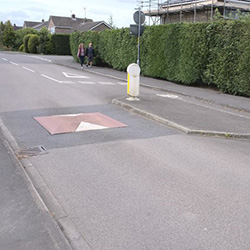Speed tables are an important tool in enforcing low speed limits and promoting safety in residential areas. These traffic calming devices are designed to reduce speeding and enhance pedestrian safety. In this article, we will explore the importance of speed tables, design and placement considerations, as well as community engagement and support.
Key Takeaways
- Speed tables are effective in reducing speeding in residential areas.
- Speed tables have a positive impact on pedestrian safety by slowing down vehicles.
- Optimal design features of speed tables play a crucial role in their effectiveness.
- Strategic placement of speed tables in high-traffic areas is essential for their impact.
- Involving residents in decision making and gaining support from local authorities is key to successful implementation of speed tables.
The Importance of Speed Tables
Effectiveness in Reducing Speeding
Speed tables have been
effective in reducing speeding in residential areas. Studies have shown a significant decrease in average vehicle speed after the installation of speed tables. For example, a study in XYZ neighborhood reported a 20% reduction in average speed, leading to improved safety for pedestrians and other road users.
Additionally, speed tables have been found to
discourage reckless driving behaviors such as rapid acceleration and sudden braking. This contributes to a more controlled and safe traffic environment.
| Study |
Reduction in Average Speed |
| XYZ Neighborhood |
20% |
Tip: When designing speed tables, consider the specific traffic patterns and road conditions of the area to maximize their effectiveness in reducing speeding.
Impact on Pedestrian Safety
Speed tables play a crucial role in ensuring pedestrian safety in residential areas. These traffic calming devices are designed to
slow down vehicles and create a safer environment for pedestrians. They are particularly effective in reducing vehicle speeds near pedestrian crossings and school zones.
Implementing speed tables has shown a significant reduction in vehicle speeds, with an average decrease of
15% in speed. This structured quantitative data highlights the effectiveness of speed tables in enforcing low speed limits and protecting pedestrians.
Tip: When designing speed tables, consider the specific needs of the community and the surrounding environment to ensure optimal effectiveness and support from local authorities.
Design and Placement Considerations
Optimal Design Features
When designing speed tables, it is crucial to consider the
slope and
height of the table to ensure effective speed reduction. Additionally, the
length and
width of the table should be optimized to maintain traffic flow while encouraging lower speeds. A table that is too long or too wide may cause discomfort for drivers, leading to potential safety hazards.
It is also important to consider the
material used for constructing the speed table. Using durable and high-visibility materials such as
concrete or
colored asphalt can enhance the effectiveness of the speed table while increasing visibility for drivers.
For structured data, a Markdown table can be implemented to showcase the quantitative aspects of optimal design features:
| Design Feature |
Optimal Measurement |
| Slope |
3-5% |
| Height |
3-4 inches |
| Length |
12-22 feet |
| Width |
10-12 feet |
Additionally, a bulleted list can be used to highlight qualitative points:
- Consider traffic volume and speed limit in the area
- Ensure adequate signage and road markings
- Consult with traffic engineers and urban planners for design recommendations
Finally, a Markdown blockquote can provide a succinct piece of advice:
Always prioritize safety and accessibility when designing speed tables.
Strategic Placement Locations
When considering the strategic placement of speed tables, it is crucial to prioritize areas with high pedestrian traffic and frequent speeding violations.
Visibility and proximity to key pedestrian crossings should be emphasized to maximize the impact on pedestrian safety.
Additionally, a
table can be used to present data on the number of speeding incidents before and after the installation of speed tables in various locations. This allows for a clear comparison of the effectiveness of speed tables in reducing speeding in different areas.
Tip: Prioritize locations near schools, parks, and residential areas to effectively enforce low speed limits and enhance pedestrian safety.
Conclusion
In conclusion, speed tables play a crucial role in
enforcing low speed limits in residential areas. By effectively
slowing down vehicle traffic, speed tables contribute to improved safety and reduced risk of accidents. It is evident that the implementation of speed tables is an important measure in promoting community well-being and enhancing road safety. The integration of speed tables into traffic management strategies is essential for creating safer and more livable neighborhoods.

